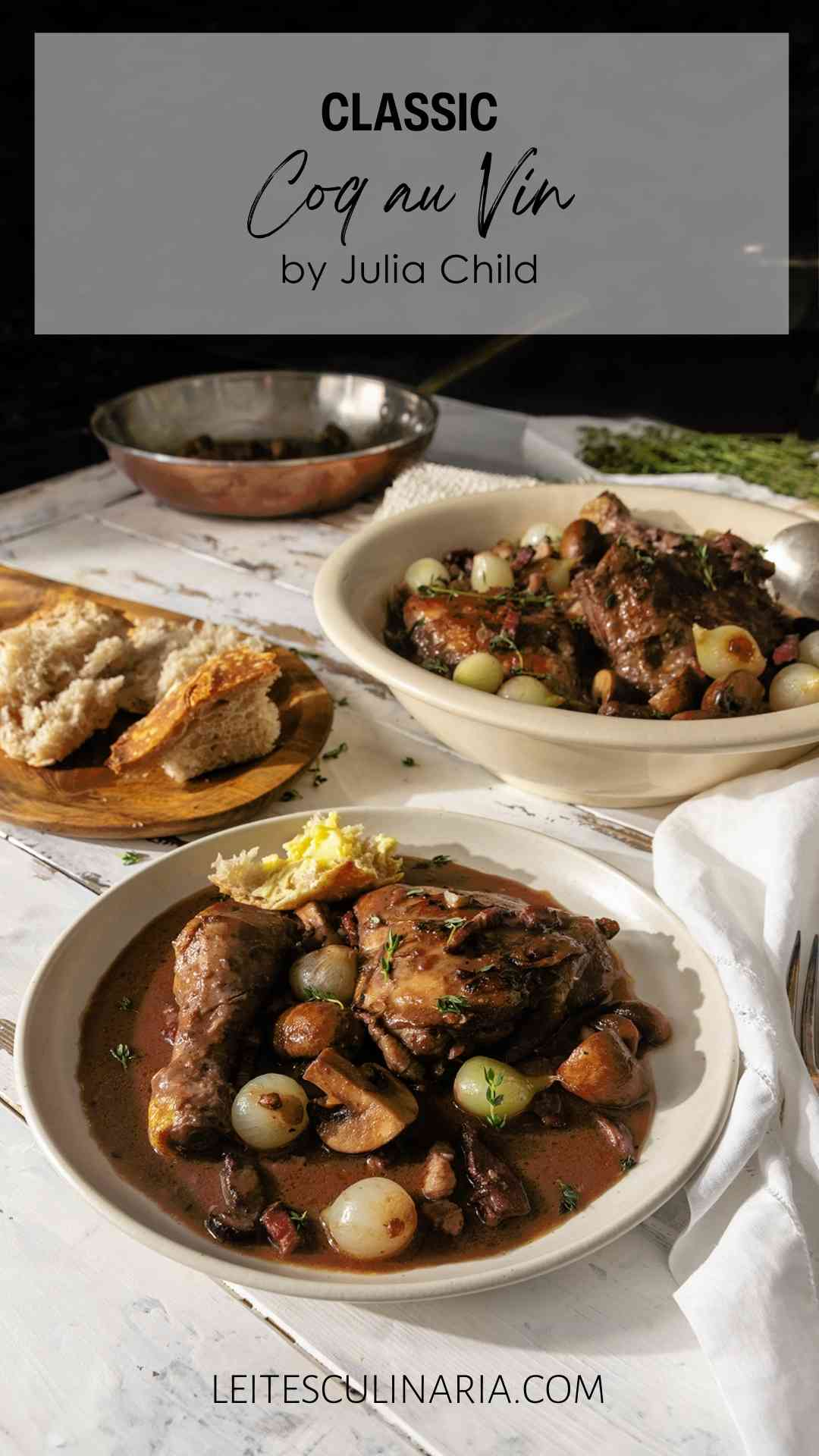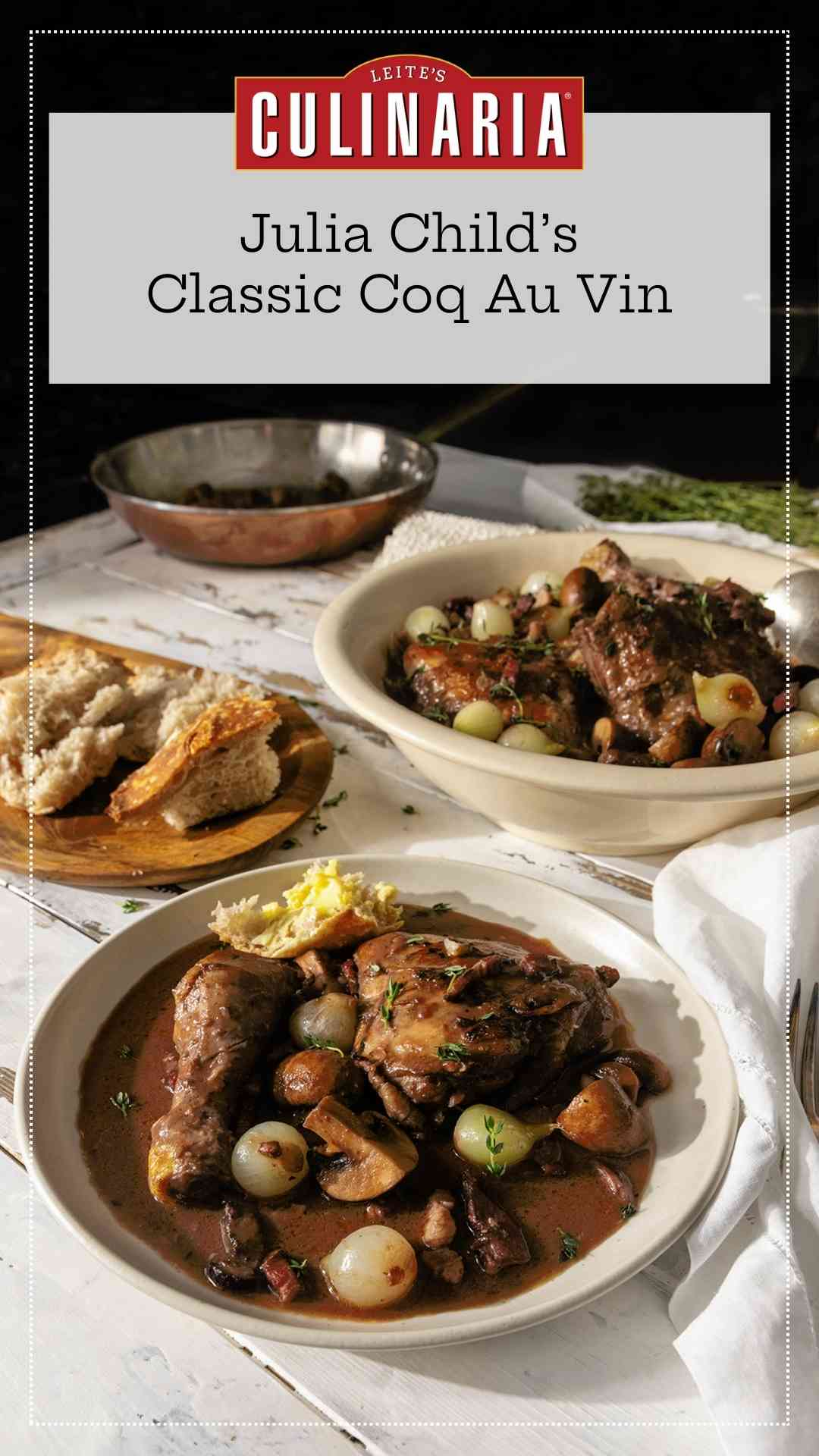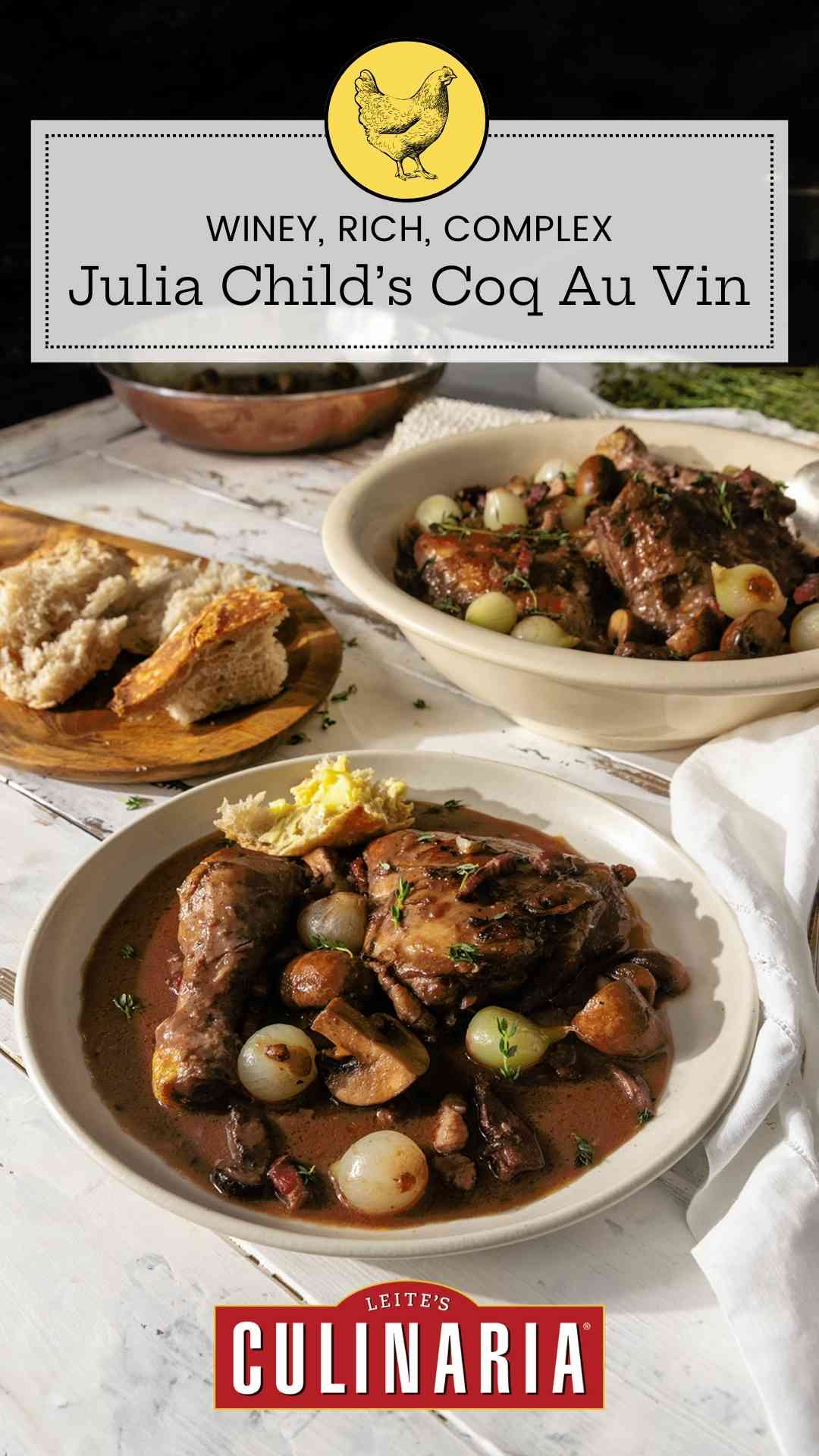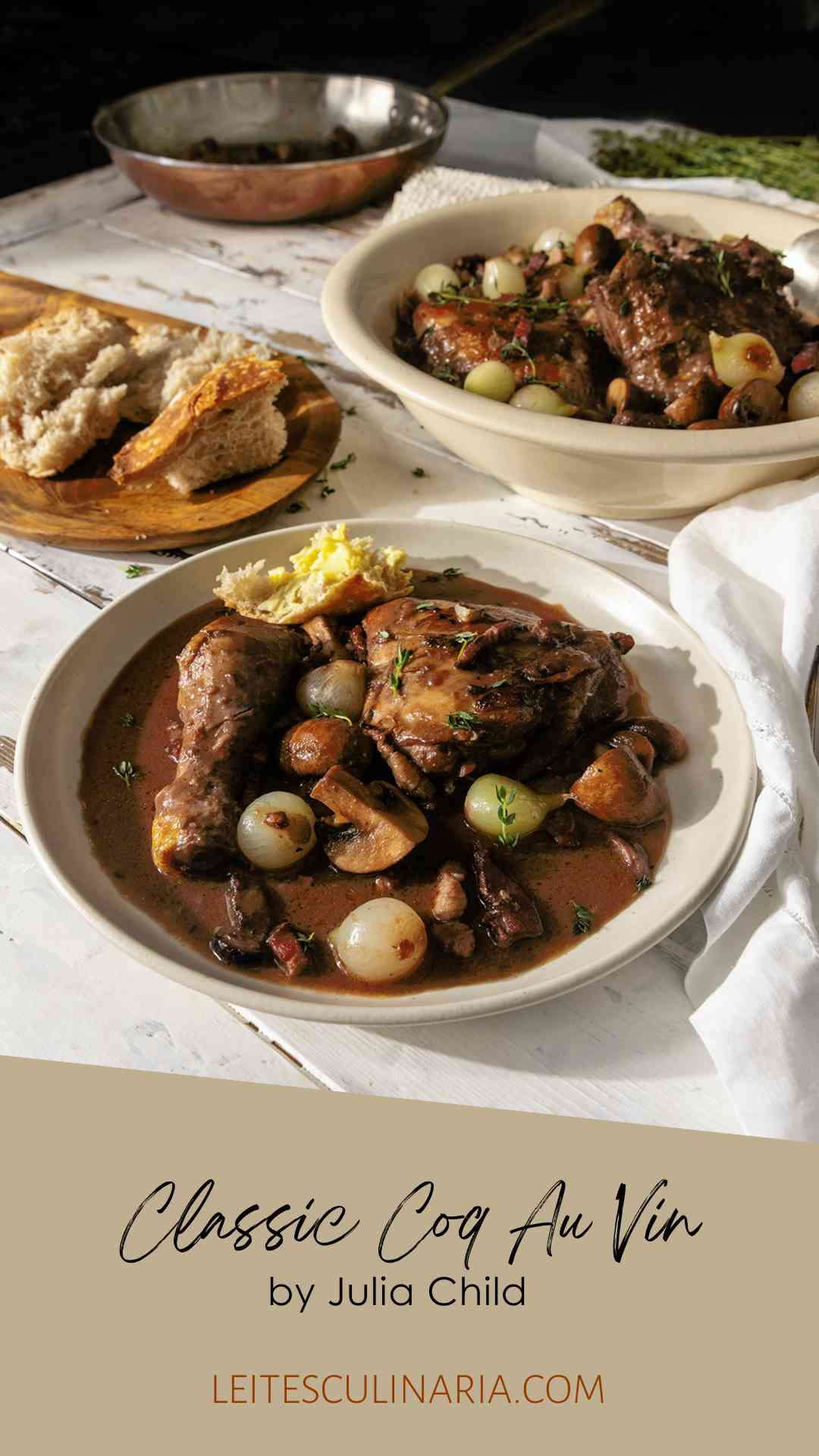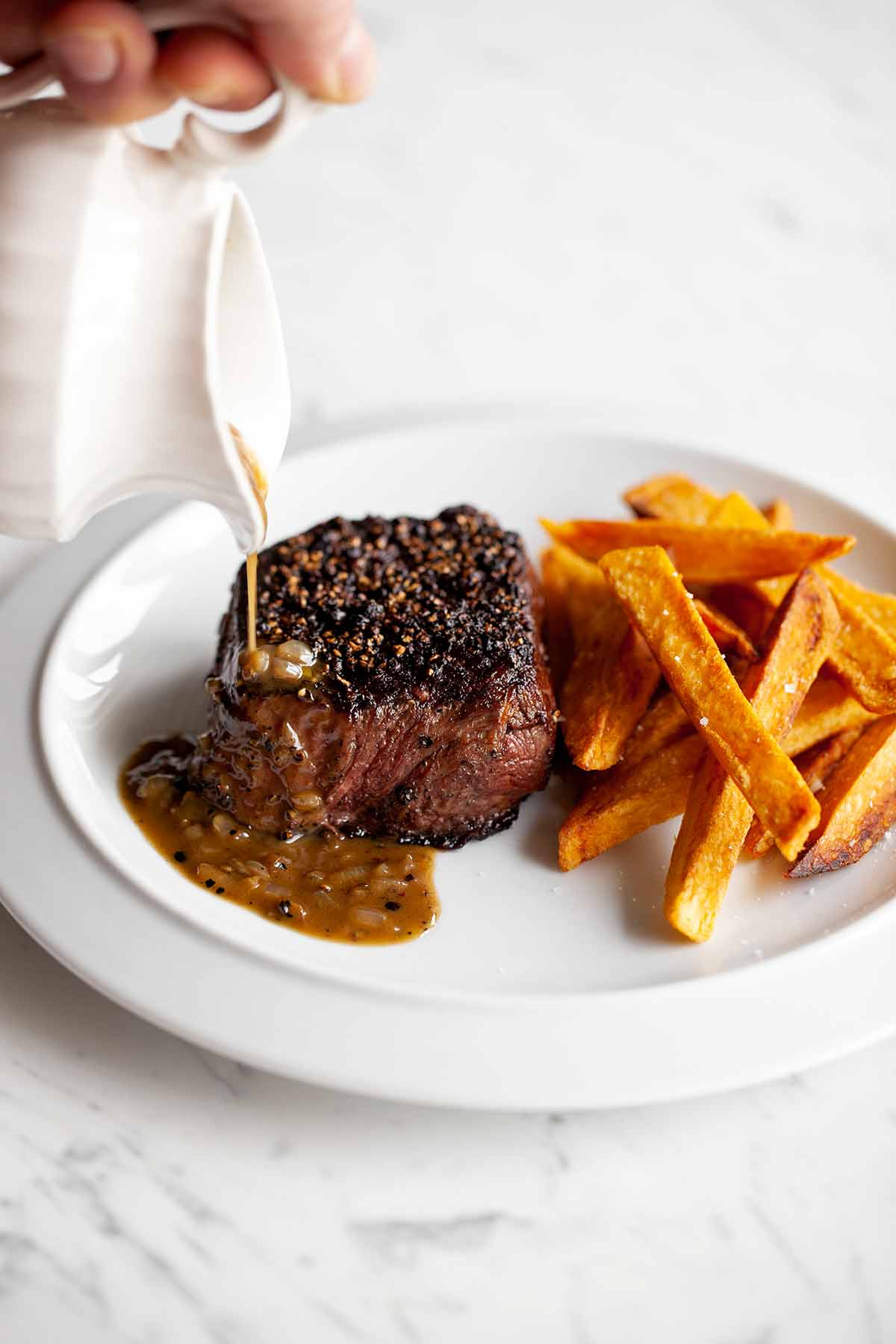
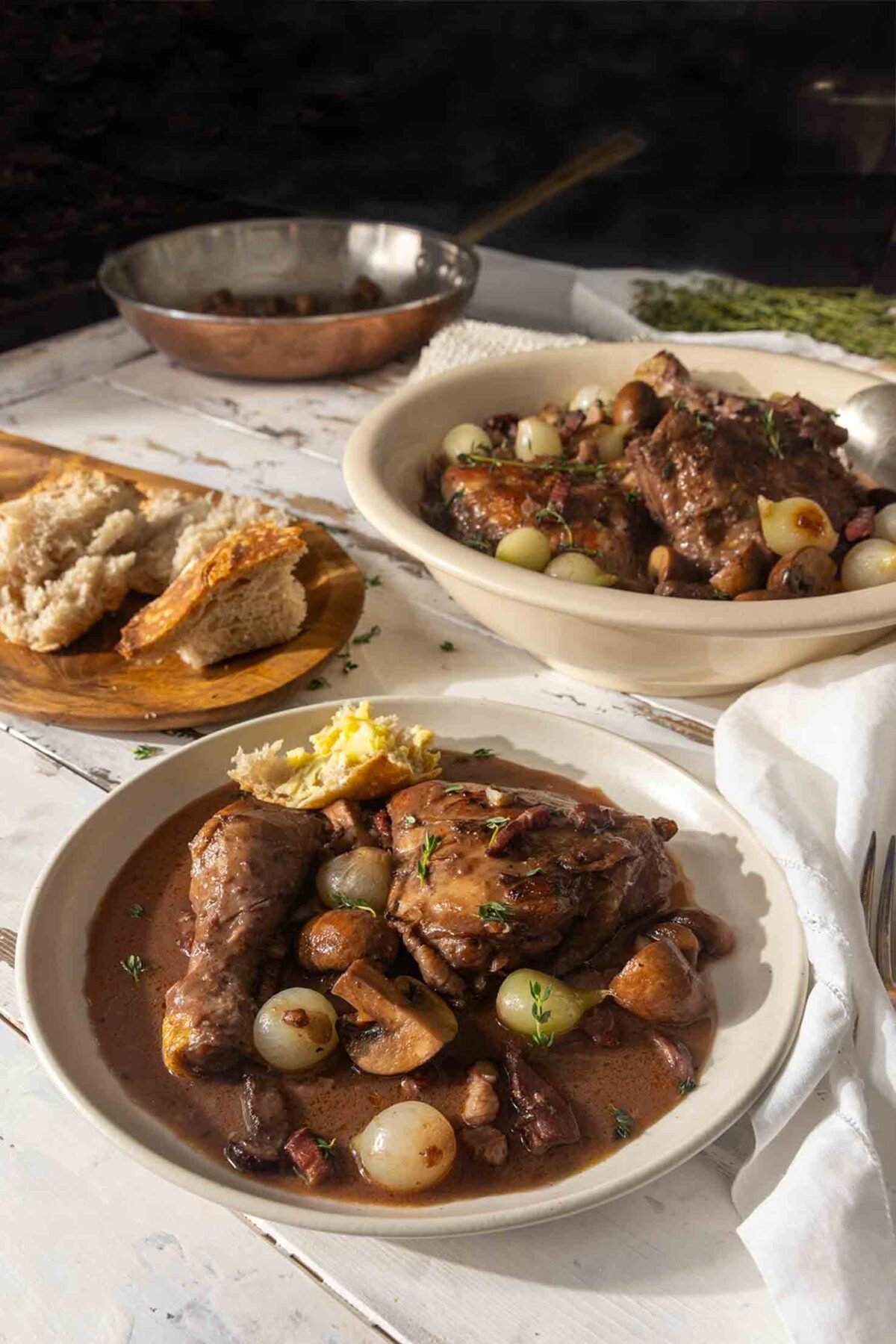
Everyone needs, nay requires, an impressive chicken dish for family, company, and special events. But no one needs the drudgery of stooping over the counter for hours putting together a recipe with a gazillion ingredients and steps.
Say bonjour to Julia Child’s coq au vin.
The only unusual ingredients, if you can call them that, are Cognac and lardons. The first is a staple at liquor stores, and you can substitute thick-cut bacon for the second. In just 1 1/2 hours, you’ll have a meal that’ll make you ache for Paris.
To be honest, I hadn’t made this dish since last winter. After whipping it up this week, I was reminded how simple, easy, and deeply flavored it is. I guess classics are classics for a reason.

Why Our Testers Loved This
Our testers were incredibly happy that this classic comfort meal could be prepared in advance or in the slow cooker. Jackie Gorman described the outstanding flavor of this dish as “succulent.”
What You’ll Need to Make This

- Lardons–Popular in French cuisine, these are strips of salty slab bacon that crisp when cooked, with just the right amount of meatiness. If you can’t find lardons, pick up slab or thickly sliced bacon and slice it into 1/4-inch matchsticks.
- Chicken–You can use any assortment of bone-in chicken pieces for coq au vin. I like using thighs and drumsticks because they’re dark meat and more flavorful.
- Cognac or Armagnac–Both are French brandies and will work equally well in the dish. Cognac is a bit smoother, while Armagnac has a bit more punch to it.
- Pearl onions–To peel pearl onions easily, blanch them in a pot of boiling water for about 2 minutes, then plunge into an ice bath. The peels will slip right off. And if you’re not in the mood for that, buy frozen pearl onions. I won’t hold it against you.
- Red wine–This is a classic French dish from the Burgundy region, so I recommend using a red from the region. But more importantly, choose one you enjoy, as it’ll be noticeable in the finished dish. Whatever you do, don’t choose a sweet wine.
- Chicken stock–For the best flavor, use homemade brown chicken stock. You can make it by searing or roasting raw chicken pieces (backs, necks, and wings are ideal) until browned, then simmering them in water with carrots, celery, and onion for 2 to 3 hours. Strain the stock before using. Store-bought chicken or beef broth can be used as a substitute.
- Mushrooms–Regular white button or brown (cremini) mushrooms work well here, but if you have access to another type of mushroom, such as shiitake, feel free to experiment.
How to Make Coq au Vin
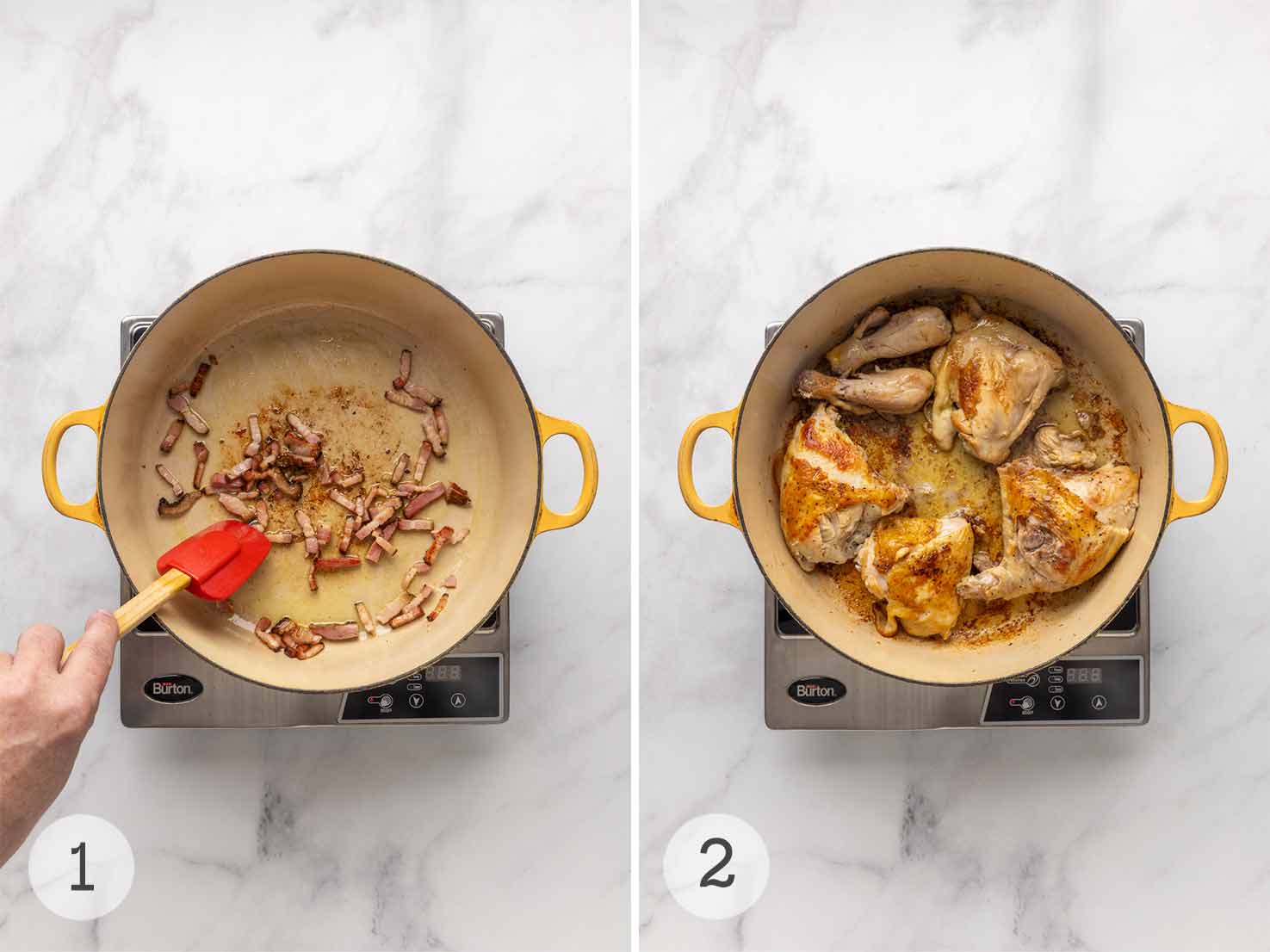
- Cook the lardons or bacon in 2 tablespoons of oil in a large pot until browned and crispy. Use a slotted spoon to transfer the lardons to a plate.
- Working in batches if necessary, brown the chicken pieces in the drippings. Return the chicken to the pot.
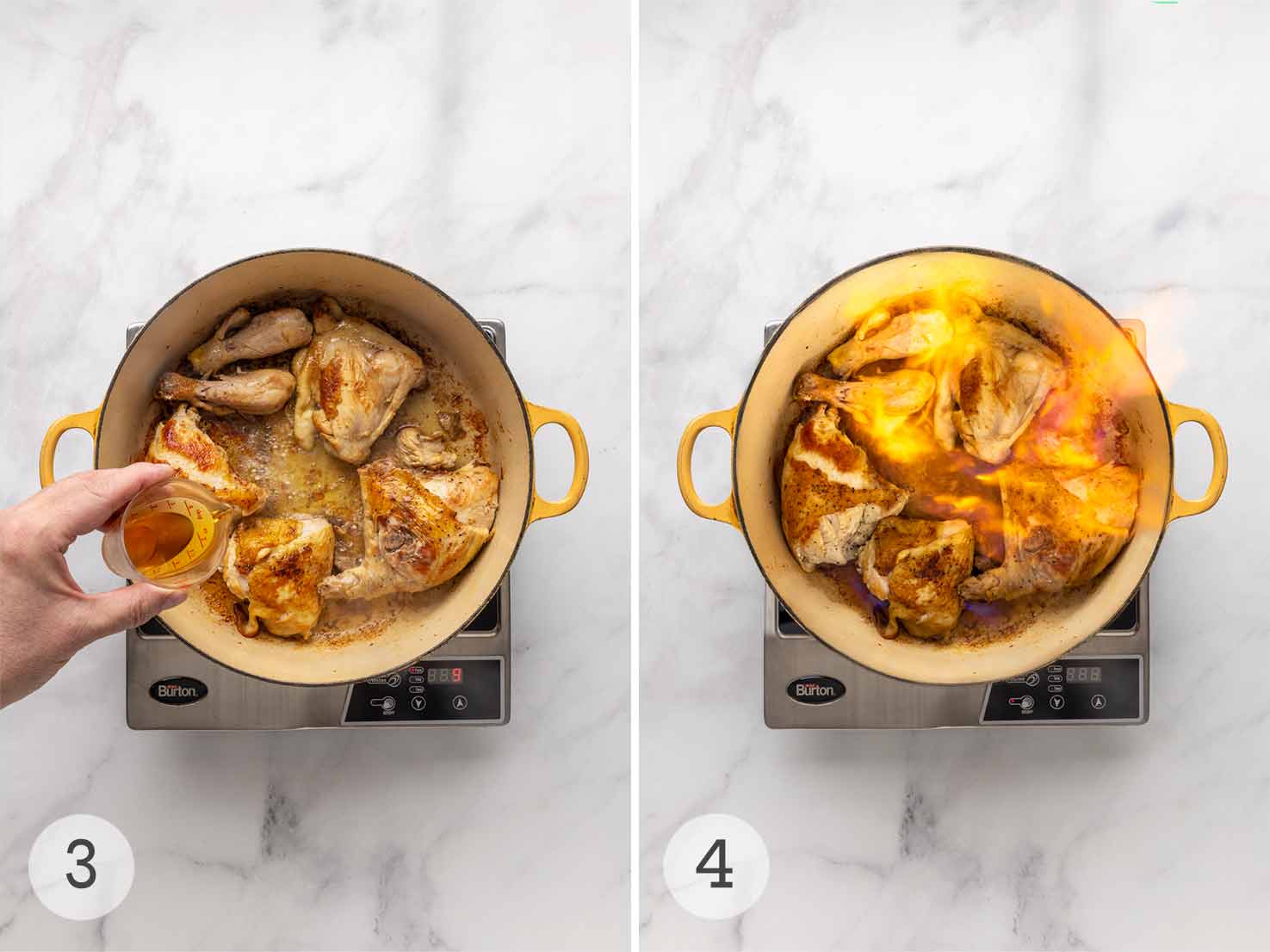
- Pour in the Cognac or Armagnac.
- Carefully(!!!!) ignite the liqueur if desired. Let the alcohol flame for a minute, then cover the pot to extinguish.
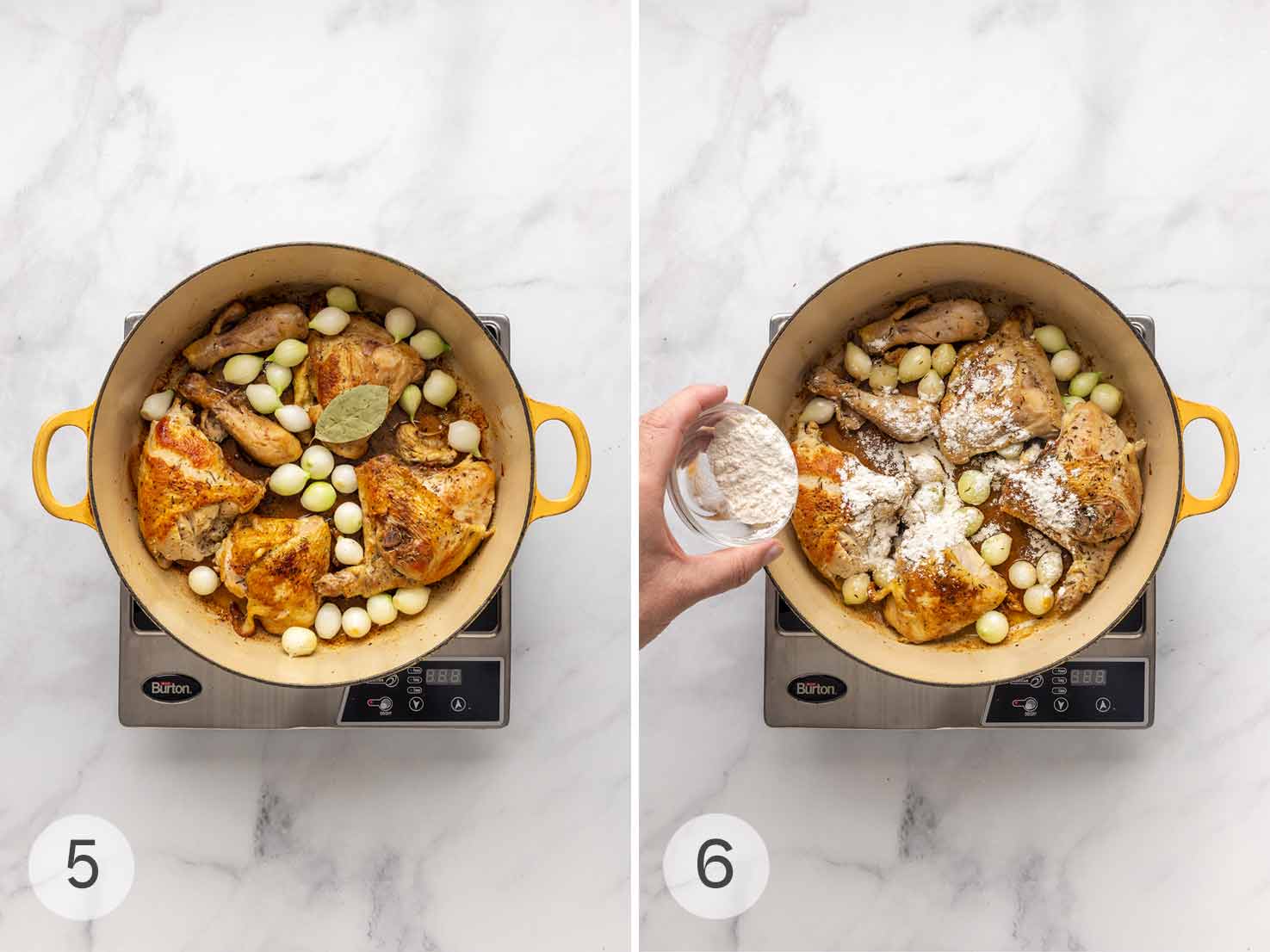
- Add the bay leaf, thyme, and onions. Cover and simmer for 10 minutes, turning the chicken pieces once. Season with salt and pepper.
- Sprinkle the flour over the chicken and turn the pieces so the flour is incorporated into the sauce. Cover and cook for 3 to 4 minutes.
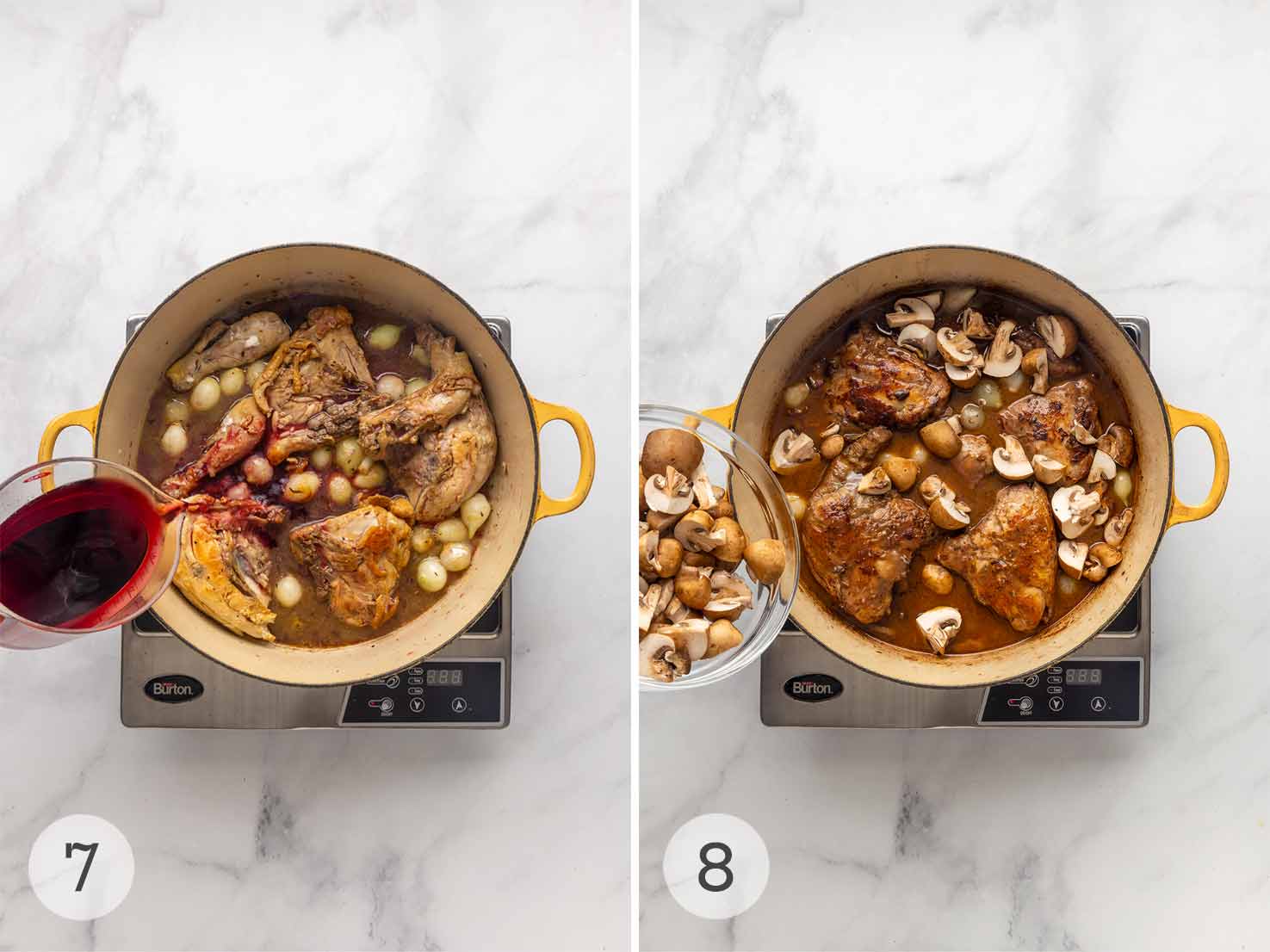
- Off the heat, swirl in the wine and stock, adding enough stock to almost cover the chicken. Stir in the lardons, garlic, and tomato paste. Cover and simmer for 25 to 30 minutes.
- Add the mushrooms and cook until tender. Season to taste and serve.
Variation: Slow Cooker Coq au Vin
Yes, you can make Julia Child’s coq au vin recipe in a slow cooker. Just understand that the complexity of this French classic relies in large part on the caramelization that comes from searing or sautéing various ingredients in a hot skillet prior to jumbling them all together to simmer. Making coq au vin in a slow cooker still turns out a lovely and worthwhile stew, albeit one with just slightly less depth of flavor.
If using the lardons (or bacon), toss them in a heavy-bottomed casserole or pot along with 2 tablespoons oil over medium or medium-high until lightly browned, about 2 minutes. Add the lardons and their drippings to the slow cooker and add the remaining ingredients except for the oil and the flour, using only 1 cup of stock.
Cook on medium heat for 5 1/2 to 6 hours, until the chicken is tender. Transfer the chicken to a platter or a serving dish.
Heat the olive oil in a saucepan over medium-high heat, stir in the flour, and cook until it forms a paste and just begins to turn brown at the edges. Stirring constantly, very slowly strain the liquid from the slow cooker into the saucepan and simmer until it has reduced to a consistency that’s thick enough to coat the back of the spoon.
Transfer the onions to a platter with the chickens and discard the bay leaf. Pour the reduced sauce over the chicken and onions.
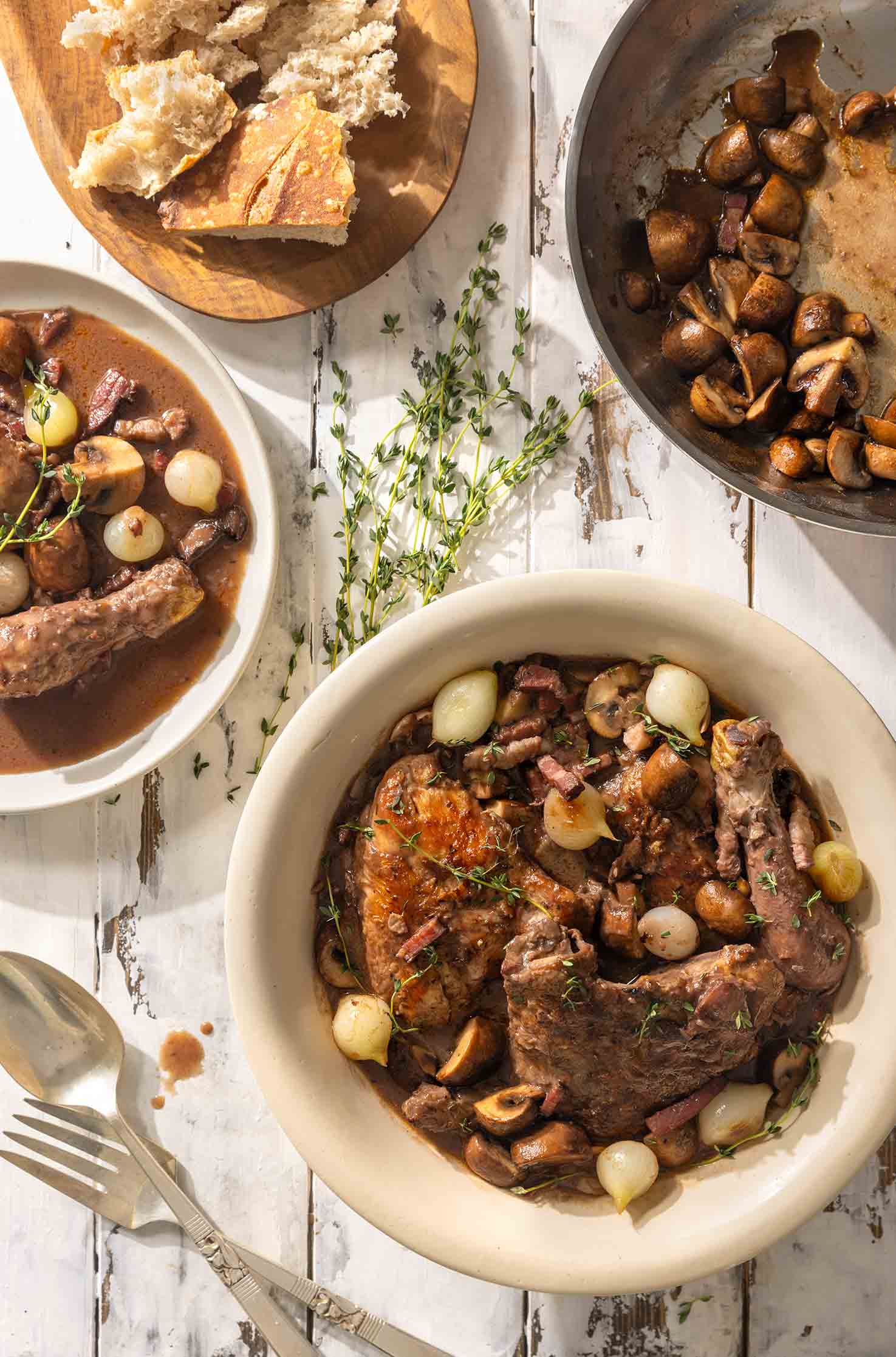
Common Questions
The literal translation of coq au vin is “rooster (cock) with wine.” Although the dish is almost always made with chicken now, the name has endured.
With all due respect to the inimitable Julia Child, that doyenne of all things French, there are more authentic versions of the classic French chicken and wine stew than her recipe. But the beauty of Julia was that she was especially conscious of translating fussy French recipes for American masses in need of manageable cooking techniques.
As such, a couple of common, though not compulsory, flavor-making steps were omitted in the making of her version of the French classic. You can consider incorporating them back into your coq au vin routine to imbue it with layer after layer of complexity.
First, uncork that bottle of red and douse the bird, allowing it to take an overnight bath in the fridge to infuse the meat with a subtle but certain depth of flavor—not to mention a slightly weird maroon hue. Drain the chicken then pat it dry and continue with the searing, reserving the wine to use during cooking.
Another easy trick? Sauté those teensy pearl onions in the rendered bacon drippings prior to adding them to the stew for what we think are obvious reasons. Same goes with the mushrooms.
And never, ever serve the stew straight away from the stovetop; rather, let it cool and then refrigerate it ’till the next day, skimming any fat from the surface and heating the coq au vin gently—and I do mean gently—over low heat until warmed through. And you thought you didn’t know how to speak French.
Although it’s not traditional, I have had many requests for how to make coq au vin with carrots added to it. I tried it and found the best way is to add 1-inch carrot chunks to the pot in step 6, along with the bacon, garlic, and tomato paste.
Julia would recommend that you use a full-bodied red Burgundy, Cotes du Rhone, or Beaujolais, and we heartily agree. That said, select a wine you enjoy drinking, as you’ll have some left to enjoy while your chicken is simmering away.
Helpful Tips
- If your chicken pieces have excess skin or fat hanging off them, trim it away before cooking.
- When searing the chicken pieces, don’t crowd the pot. This will lead to steaming instead of searing. The pieces should fit comfortably in the bottom of the pot, with a bit of space between each piece. Brown the chicken in batches if necessary.
Storage & Reheating Instructions
You can prepare this coq au vin recipe up to 3 days before serving it. Store it in a sealed container in the refrigerator, then gently reheat it in a large pot or Dutch oven over low heat until everything is warmed through.
What to Serve with this Recipe
You’ll want to sop up every last drop of that beautiful sauce, so I highly recommend serving this with mashed potatoes, or some artisan bread.
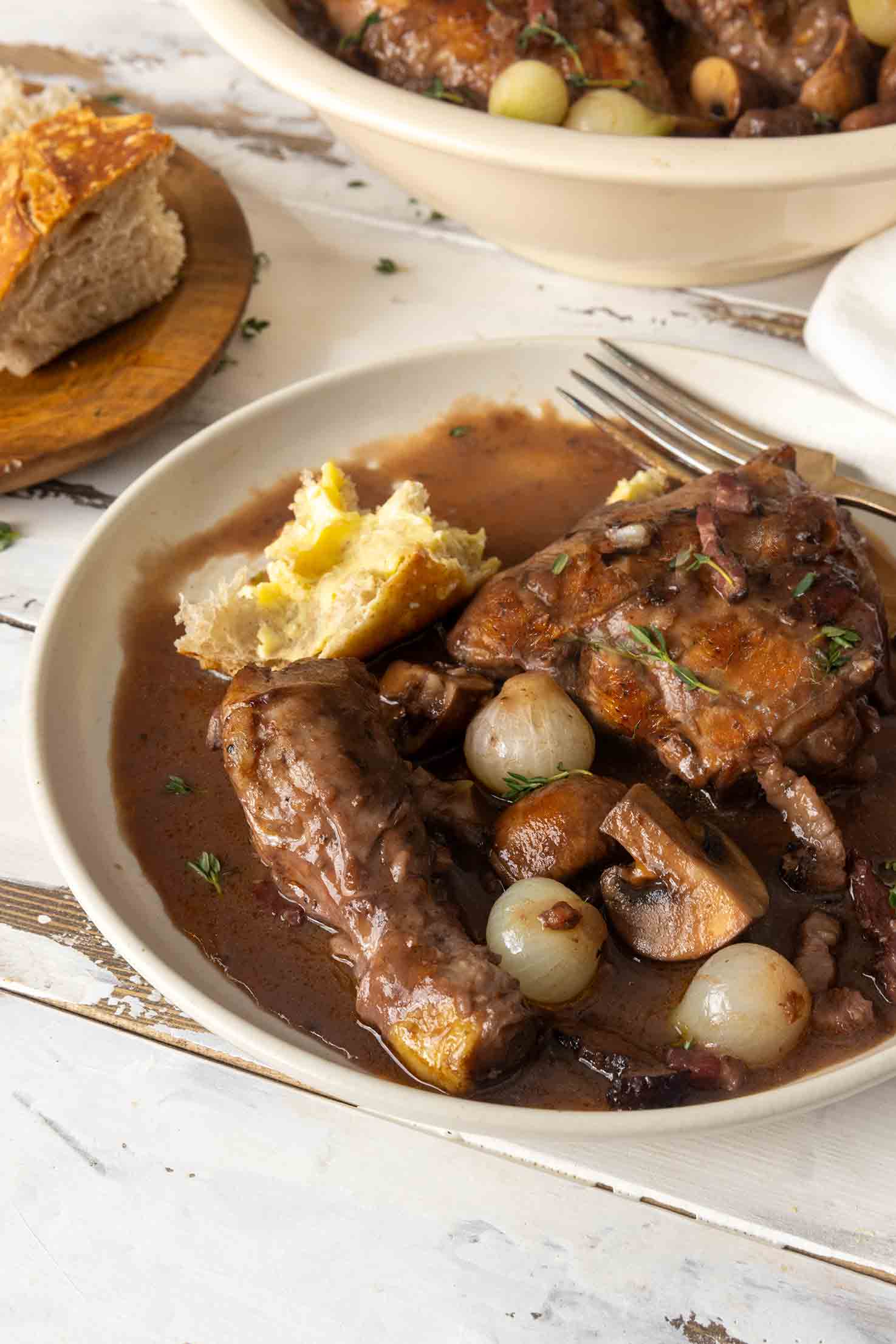
Write a Review
If you make this recipe, or any dish on LC, consider leaving a review, a star rating, and your best photo in the comments below. I love hearing from you.–David
This is the best coq au vin recipe I’ve ever eaten. Absolutely delicious and great to make ahead.
Karen
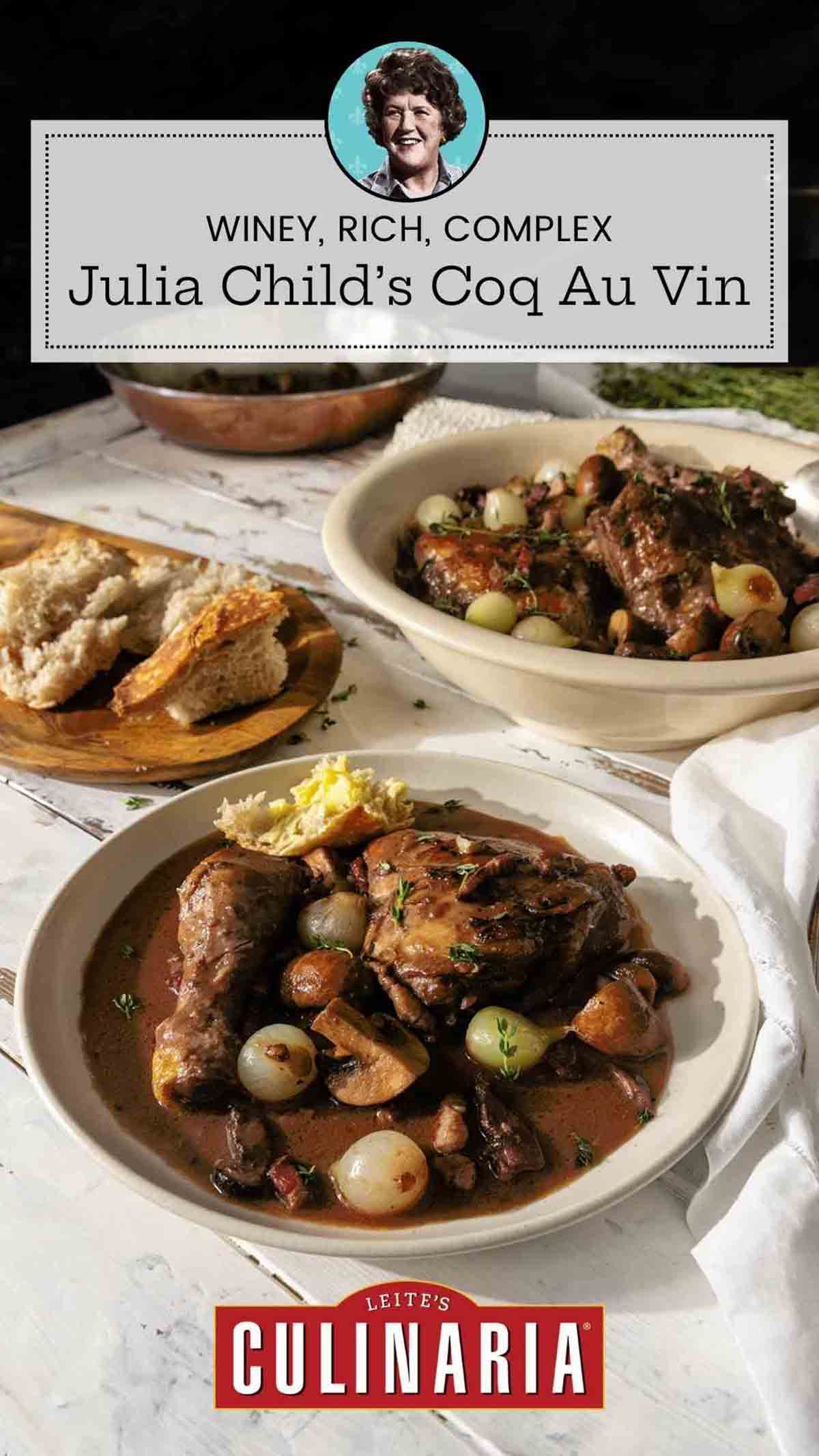
- 1/2 cup lardons or thickly sliced bacon, cut into 1/4- by 1 1/2-inch (6- by 36-mm) strips (optional)
- 2 or more tablespoons olive oil
- 3 1/2 to 4 1/2 pounds chicken, cut into pieces (or all the same piece), thoroughly dried with paper towel
- 1/4 cup Cognac or Armagnac
- Salt and freshly ground black pepper
- 1 bay leaf
- 1/4 teaspoon dried thyme
- 20 pearl onions, peeled
- 3 tablespoons all-purpose flour
- 2 cups red wine, preferably Burgundy, Côtes du Rhône, or pinot noir
- About 2 cups homemade chicken stock or beef stock, preferably brown chicken stock (see headnote above)
- 2 garlic cloves, mashed
- About 1 tablespoon store-bought or homemade tomato paste
- 3/4 pound fresh mushrooms, trimmed, rinsed, and quartered
- Fresh thyme sprigs, for garnish (optional)
Prevent your screen from going dark
Sear the lardons or bacon in the oil in a heavy-bottomed pot over medium-high heat until lightly browned, about 2 minutes. Transfer to a plate, leaving the drippings in the pot.
Add the chicken, being careful not to crowd the pieces. You may need to work in batches. Sear the chicken, turning occasionally, until nicely browned on all sides. (If working in batches, return all the chicken to the pot.)
Carefully pour the Cognac into the pot and wait until it becomes bubbling hot. If desired—and if you’re brave—ignite the sauce with a match. Let it flame for a minute, gently tilting the pot by its handle and swirling the sauce to burn off the alcohol. To extinguish the flames, simply cover the pan with its lid.
Add the bay leaf and thyme to the pan, nestle the onions around the chicken, and season with salt and pepper. Cover the pot and simmer gently, turning the pieces once for about 10 minutes.
Uncover the pot, sprinkle the flour over everything, and turn the chicken and onions so the flour is absorbed by the sauce. Cover and cook, turning once or twice, for 3 to 4 minutes more.
Remove the pot from the heat and gradually stir in the wine and enough stock to almost cover the chicken. Add the lardons, garlic, and tomato paste, cover, and simmer gently for 25 to 30 minutes.
Test the chicken for doneness. (There should be no trace of pink, and the juices should run clear when the meat is pierced with a knife.) Transfer the pieces to the plate when they’re done.
If the onions aren’t quite tender, continue cooking them in the sauce, then return the chicken to the pot, add the mushrooms, and simmer for 4 to 5 minutes.
The sauce should be just thick enough to coat the chicken and vegetables lightly. (If the sauce is too thin, bring it to a boil and reduce it to the desired consistency. If the sauce is too thick, thin it with spoonfuls of stock.) Taste and correct the seasoning accordingly.
Serve immediately, garnished with thyme sprigs.
- Trimming the chicken–If your chicken pieces have excess skin or fat that hangs off of them, trim it away before cooking.
- Storage and reheating–You can prepare this coq au vin recipe up to 3 days before serving it. Store it in a sealed container in the refrigerator, then gently reheat it in a large pot or Dutch oven over low heat until everything is warmed through.
Serving: 1 portionCalories: 1081 kcalCarbohydrates: 30 gProtein: 49 gFat: 71 gSaturated Fat: 22 gMonounsaturated Fat: 33 gTrans Fat: 0.2 gCholesterol: 195 mgSodium: 426 mgFiber: 4 gSugar: 11 g
Nutrition information is automatically calculated, so should only be used as an approximation.
Recipe © 1979 Julia Child. Photos © 2024 David Leite. All rights reserved.
Recipe Testers’ Reviews
Wonderful recipe, Julia! Great layers and depth of flavors.
I made this using 9 skin-on, bone-in chicken thighs. I seasoned the thighs with salt and pepper before browning them in a Dutch oven because that seemed to make more sense than seasoning them afterward.
After browning the chicken thighs in batches, I browned the pearl onions in the bacon grease mixed with the fat from the chicken thighs. There was too much chicken fat left in the pot, as well as a charred buildup, so we cleaned the pan before adding the Armagnac, igniting it, and proceeding with the recipe.
I used 2 cups Syrah for the red wine, since Syrah is one of the grapes used in Côtes du Rhône. When it came to finally simmering the chicken, the thighs were done after 20 minutes. The onions were not quite done at this point, so I removed the chicken, added the mushrooms, and simmered for about 3 to 4 minutes more. I allowed everything to cool down, put the chicken back into the pot, and put the pot into the refrigerator.
The next day I took the pot out a couple of hours before dinner to let everything come up to room temperature before reheating. There was no congealed fat on the surface of the stew. I think that cleaning out the pot after browning the chicken and the onions was the way to go.
I let everything warm up very, very slowly on a simmer setting. I made mashed potatoes using a ricer so that they were extremely silky and creamy.
Julia Child’s coq au vin served over the mashed potatoes was, in a word, succulent. By the way, I added more mushrooms and pearl onions than the recipe called for, and we hungered for even more. This was a beautiful dish served with multi-colored baby carrots.
We had an Oregon medium-bodied pinot with this dish. It was a good choice, because it let the coq au vin shine on its own. A bigger wine would’ve overpowered it.
I adapted Julia Child’s coq au vin recipe for a slow cooker.
I put all the ingredients except the olive oil and the flour in the slow cooker and cooked it on medium heat for 6 hours. I omitted the bacon/lardons. I used the full 2 cups wine but only 1 cup broth. I used bone-in skin-on chicken legs and thighs (about 4 pounds).
When the chicken was tender, I transferred it to a bowl, heated the olive oil in a pot, added the flour and cooked it, and stirred in the entire amount of liquid from the slow cooker and reduced it so that it was thick enough to coat the chicken.
The chicken was incredibly juicy, tender, and flavorful. I could perhaps have reduced the cooking time to about 5 1/2 hours and been just fine. This worked really well for me.

